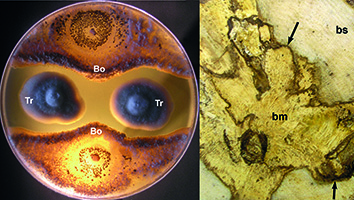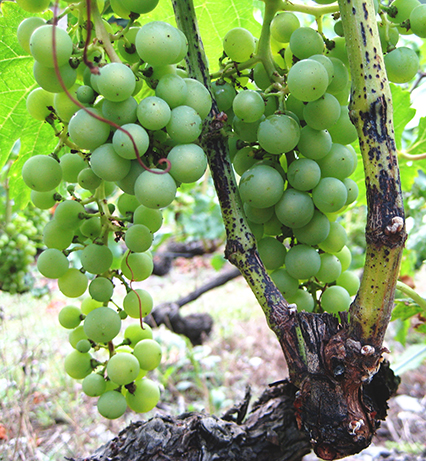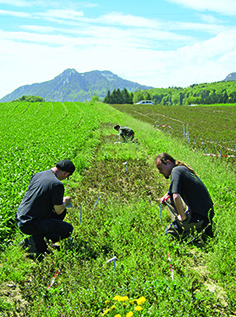
Issue 2 - March - April 2017


Abstract in open access
In 2015, Agroscope performed an international inquiry for the French association “Lien de la vigne” (Vinelink International), http://www.liendelavigne.org/). This survey focused on the concerns of winegrowers and scientists over grapevine trunk diseases. The present publication summarizes the strengths of this inquiry and presents the research directions adopted by Agroscope to answer these concerns in relation with the available knowledge about these diseases. This publication also aims to familiarize the winegrowers and the public with the complex issue of grapevine trunk diseases.
Keywords: esca disease, disease-associated fungi, metabolomic, plant physiology.
E-Mail: valerie.hofstetter@agroscope.admin.ch
Adress: Agroscope, 1260 Changins/Nyon




Abstract in open access
The objective of this work is to provide for professionals of the wine sector objective elements on the relevance of a strategy of environmental communication in PDO wines and to measure the interaction perceived by the consumers between PDO and environment according to itslevel of notoriety. The work was undertaken between 2012 and 2015 starting from x-ray groups and 3700 surveys conducted into Internet and the social networks. The results got clear differences in perception by the consumers on the link between “categories of wines” and “respectful production for the environment”. Overall the wines of PDO are perceived like significantly more respectful for the environment than the better perceived wines of IGP, themselves better percieved than the wines of France. In addition, the reputation of aPDO can affect the perception of the environmental respect. For the consumers, the impact of the wine region seems more important than the reputation of a PDO as for “the perceived environmental image” It seems clear in the case of the French wine sector than the use of environmental messages as element of differentiation and competitiveness for the wines of PDO does not answer waiting of the majority of the consumers.
Keywords: Consumers, environment, involvement.
E-Mail: f.jourjon@groupe-esa.com
Adress: Ecole supérieure d'agriculture d'Angers ESA, F-49007 Angers Cedex 01

Abstract in open access
Disease resistant apple varieties and selections were planted at Agroscope in Wädenswil in two plots in 2010. All varieties and selections planted in plot Wa.64 were also fire blight tolerant. Fruit and tree features were evaluated incl. sensory tests and storage. Based on the results from five years observation it can be concluded that the cvs. ‘Ladina’ and ‘WUR 159’ (Natyra®) are not only disease tolerant but also display an outstanding fruit quality. In addition, ‘Ladina’ is productive but susceptible to Marssonina leaf blotch. After longer storage Ladina is susceptible to superficial scald. ‘WUR159’ (Natyra®) has good storage capacity, but its tree vigour is rather weak and tree volume low. Trees of ‘Lucy’ are vigorous with a tendency to biannual bearing and consequently they have a medium yield index, while its fruits are susceptible to rotting in storage. ‘Imara’ displays a low pack-out due to its large fruit and low coloration. ‘WUR 133’ (Allurél®), too, colours rather inhomogeneous. ,ACW 14995’ whith green-yellow fruits has good flavor and will be tested, as well as ,ACW 15097’, for suitability in apple juice production. ‘Solaris’ is also green yellow and not especially productive and will, like ‘UEB 3205/2’, not be further considered by the Czech breeders. ‘Rubinstep’, ‘ACW 13434’, ‘ACW 13007’ and ‘ACW 14812 showed no outstanding features in these conditions.
Keywords: apple, disease resistance, fire blight, fruit quality, yield.
E-Mail: markus.kellerhals@agroscope.admin.ch
Adress: Agroscope, 8820 Wädenswil

Abstract in open access
In organic farming, weed management is a key factor of productivity and profitability. Since ten years, some Swiss mint producers shelter their crops with polypropylene (PP) groundcover during the winter. To assess the impact of this innovative technique, four covered and uncovered mint fields were monitored during winter 2012–2013. In these tests, PP mulching significantly promoted dry matter production of the first annual harvest of four mint clones (+5–12 kg/a depending on the clones). The inhibitory effect on the weed flora was convincing. In covered plots, time for manual weeding was reduced by 4.4 h/a. The protective and positive action of PP mulching for the soil was highlighted. Soil porosity, microbial biomass and nitrogen mineralization were notably improved. In Conthey, during winter 2014–2015, the action of the PP cover on the temperature at the soil and roots level was also studied. The amplitude of the temperature fluctuations has been severely limited, as well as the number of days of cold. In contrast, the average temperature was only slightly higher (+0.3 °C). The appropriate date to uncover the fields in spring remains controversial. The experience combined to an approach based on fruit trees phenology could help to refine the practical recommendations.
Keywords: Mentha, PP woven ground cover, weed management, yield, profitability
E-Mail: claude-alain.carron@agroscope.admin.ch
Adress: Agroscope, 1964 Conthey


 Download of full issue
Download of full issue
 Download article
Download article